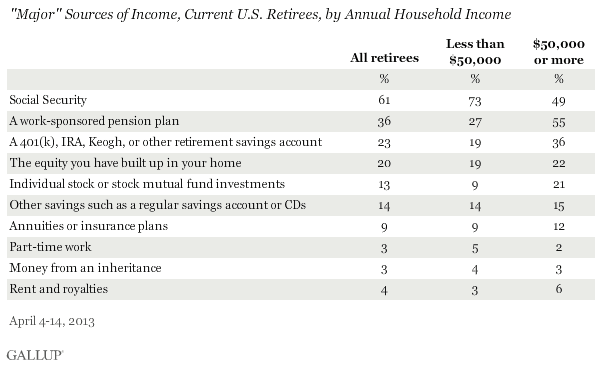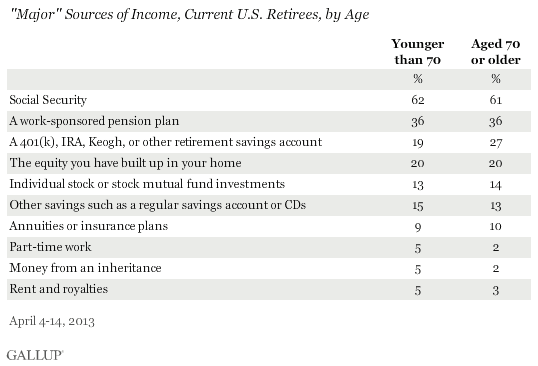PRINCETON, NJ -- U.S. retirees with $50,000 or more in annual income are twice as likely as retirees below that threshold to say a work-sponsored pension plan is a major source of retirement funds. Instead, these lower-income retirees overwhelmingly cite Social Security as a major source of their retirement income.

The results are based on Gallup's annual Economy and Personal Finance survey, conducted April 4-14 with more than 2,000 U.S. adults, including 636 retirees.
Among all U.S. retirees, Social Security continues to be the most commonly cited source of retirement funds, with 61% calling it a major source, followed by pension plans (36%), 401(k), IRA, or other retirement savings accounts (23%), and home equity (20%). Those sources differ from nonretirees' expected retirement income sources, with self-directed savings accounts such as 401(k) plans or IRAs topping the list of funding streams that pre-retirees expect to rely most on.
Pension plans appear to be a major factor in determining retirees' standard of living, given that they are the most commonly cited income source among retirees whose annual household income is at or above the U.S. median of roughly $50,000. Social Security is the next-most-common "major source" of funds among wealthier retirees, followed by self-directed retirement savings accounts such as 401(k) plans or IRAs.
Retirees below the median household income are heavily dependent on Social Security payments, as the 73% saying it is a major source is nearly triple that of the next-most-common source among this group -- pension plans, at 27%.
New Era of Retirement Not Here Yet
The retirement landscape is shifting, as more nonretirees expect to rely on self-directed retirement savings accounts and less on the sources like pensions and Social Security that chiefly provide income for today's retirees. But the data suggest the new era of retirement has not necessarily arrived yet -- younger and older retirees today largely rely on the same funding sources.
Specifically, 62% of retirees younger than age 70 say Social Security is a major source of retirement funds for them, compared with 61% of retirees aged 70 or older. Thirty-six percent of both age groups say pension plans are a major source of retirement income. In fact, the only noticeable difference between younger and older retirees comes in the extent to which they rely on 401(k) plans or IRAs, with older retirees more likely to cite these as a major source of retirement funds.

Implications
Pension plans seem to be a major factor relating to how financially well off U.S. retirees are. With Social Security by far the major source of retirement funding among U.S. retirees, those who can supplement that money with income from a pension plan or other source appear to be doing much better.
Of course, those with pension plans may have been working in professions that paid better to begin with, and thus, having a pension plan may not be a cause of having greater income on average during retirement. Income differences among retirees today may then be a continuation of income differences that were in place before they retired, and it so happened that higher-income workers were more likely than lower-income workers to have pension benefits.
The retirement landscape is changing, with fewer employers now offering pension plans and shifting toward offering employees self-directed retirement savings plans. Twenty-four percent of nonretirees say a work-sponsored pension plan will be a major source of retirement income for them, compared with the 36% of current retirees relying to a large degree on pensions.
One critical factor in determining the financial security of tomorrow's retirees will be whether the money they can save through 401(k)s or IRAs is sufficient to replace the income many of today's retirees are getting from pension plans.
Data from Fidelity Investments, the largest holder of 401(k) plans, suggest investors' average 401(k) balance was roughly $77,000 at the end of 2012. That figure likely should have gone up by at least 10%, given the average increase in stock prices this year. However, if those nearing retirement age have balances around the national average, these balances will almost certainly be inadequate to fund their retirement, making them more dependent on Social Security.
Pension plans are a way to force employees to save for retirement. Future retirees who lack such a retirement option will need to rely more on their own discipline to ensure that they can make ends meet in retirement, particularly given the financial challenges facing the Social Security and Medicare systems.
Survey Methods
Results for this Gallup poll are based on telephone interviews conducted April 4-14, 2013, with a random sample of 636 retirees, aged 18 and older, living in all 50 U.S. states and the District of Columbia.
For results based on the total sample of retirees, one can say with 95% confidence that the margin of sampling error is ±5 percentage points.
Interviews are conducted with respondents on landline telephones and cellular phones, with interviews conducted in Spanish for respondents who are primarily Spanish-speaking. Each sample of national adults includes a minimum quota of 50% cellphone respondents and 50% landline respondents, with additional minimum quotas by region. Landline telephone numbers are chosen at random among listed telephone numbers. Cellphone numbers are selected using random digit dial methods. Landline respondents are chosen at random within each household on the basis of which member had the most recent birthday.
Samples are weighted to correct for unequal selection probability, nonresponse, and double coverage of landline and cell users in the two sampling frames. They are also weighted to match the national demographics of gender, age, race, Hispanic ethnicity, education, region, population density, and phone status (cellphone only/landline only/both, cellphone mostly, and having an unlisted landline number). Demographic weighting targets are based on the March 2012 Current Population Survey figures for the aged 18 and older U.S. population. Phone status targets are based on the July-December 2011 National Health Interview Survey. Population density targets are based on the 2010 census. All reported margins of sampling error include the computed design effects for weighting.
In addition to sampling error, question wording and practical difficulties in conducting surveys can introduce error or bias into the findings of public opinion polls.
For more details on Gallup's polling methodology, visit www.gallup.com.
